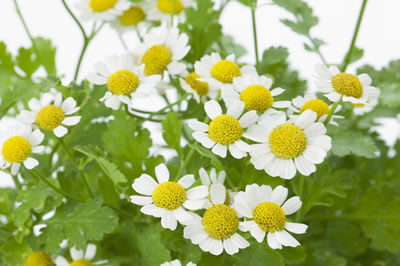Feverfew
 Belonging to the Asteraceae family of plants, feverfew (Tanacetum parthenium L.Schultz Bip), is native to the Balkan Peninsula but now is a widespread weed
Belonging to the Asteraceae family of plants, feverfew (Tanacetum parthenium L.Schultz Bip), is native to the Balkan Peninsula but now is a widespread weed
throughout the world. It was recorded in the first century as an anti-inflammatory by the Greek physician Dioscorides.
The plant grows into a small bush and has pretty, daisy-like flowers and characteristic scented leaves. It spreads rapidly, and if not tamed the plant will cover a wide area after a few years.
Other common names for feverfew include Altamisa, batchelor’s buttons, featherfew and featherfoil.
History of Use
The word “feverfew” is derived from the Latin word febrifugia, meaning “fever reducer”, although it is no longer considered useful for that purpose. The herb has also previously been used to relieve rheumatic conditions, and even mixed with sugar and honey to soothe coughs.
Today, feverfew is believed to have anti-inflammatory properties and it’s approved use is for the prevention of migraine headaches which can last for hours or days, and may be preceded by warning signs.
When the herb is chewed or taken orally it can very occasionally cause mouth ulcers and swelling and numbness of the mouth. Modern-day tablet and capsule forms of the herb help to prevent such a reaction.
Did You Know?
A migraine is a severe, throbbing headache that usually begins on one side of the head hence the name ‘migraine’ from the Greek, hemikrania, or ‘half the skull’.

Since April 2014, all herbal medicines for sale in the UK and Europe must be approved by the Medicines & Healthcare Products Regulatory Agency (MHRA) having been rigorously checked for safety and quality. They must also display the Traditional Herbal Registration ‘THR’ logo on their pack.
Registered herbal medicines containing feverfew leaf are used today for the prevention of migraine headaches. Based upon traditional use only.
